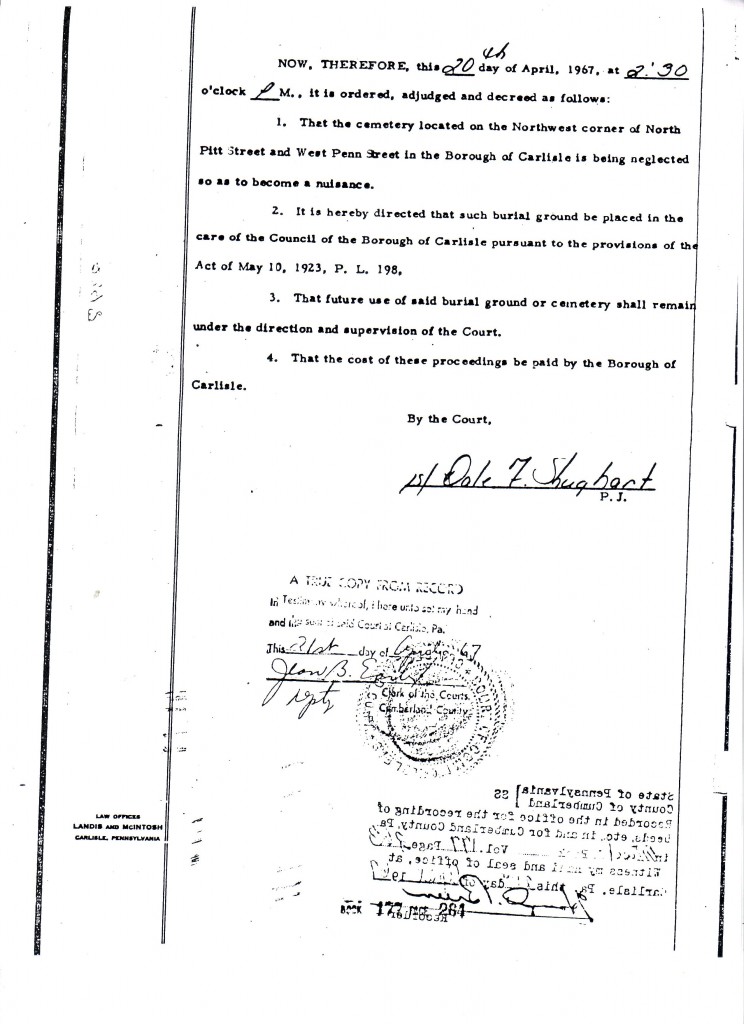Jim Washington has been a huge help throughout my research on Lincoln Cemetery. I have met with him multiple time to talk about the history of the cemetery and he has been pivotal in both finding contacts and figuring out where to expand upon previous research.
In a recent visit, he allowed me to photocopy what he has researched on the cemetery. First, he had three newspapers articles on the cemetery from March of 1967. This is when the discussion on the cemetery first began.
March 15th, the article explains who the lawyer was that introduced the case, J. Boyd Landis, to take over the cemetery. It always says who the judge was and how long they believe the cemetery was in use. Furthermore, it touches on the multiple names of this space. I have heard it referred to as Lincoln Cemetery, the Colored Cemetery, N Pitt St. Cemetery, African American Cemetery, James Young Memorial Park, Memorial Park, Hope Station, and the Old Colored Graveyard. The March 17 article is very interesting because it has a picture of the gravestones. I have not tracked down this picture or the photographer yet. It also says that there were 78 gravestones and that a man named Richard C. Reed drew up sketches for the proposed park. The third article, from March 20th, explains the decision to assume control of the graveyard. It also says that “Barry Kohn, Dickinson School of Law Student, represented the Community Action Program (CAP) responsible for obtaining the signatures on the petition” to take over the cemetery.
Jim Washington also obtained the court order from 1967 that would shortly follow those articles. It is likely that many of these documents came from CCHS, but Washington could not confirm.
The first part of the court order explains the reasons for taking over the cemetery, who testified at the hearing and what the Borough’s role has been with the maintenance of the area. The second part shows the signatures and ruling of the court. I also believe that point 2 is the act that allowed the court to rule this, though I have not looked into that.
Jim Washington also had a different, what I will call circle map, of the positions of the headstones. I knew Cavenagh had created one of these, but this was a different one. Unfortunately, there is no identifying information on the paper and Washington does not know how he obtained it.
While I do not have a list of who each circle represents, I could still use this circle map and compare it to Cavenagh’s to see if the headstone positions agree with each other.
Jim Washington also had a number of documents from more current times. First, he has a speech from May 31st, 1999. It touches on brief biographies of George Fisher, Alfred Whiting, Charles Howard and R. H. Howard. Charles Howard actually is Jim Washington’s Great-Great Grandfather. All four of these veterans enlisted in the 54th Massachussetts, which was the first black regiment formed during the Civil War.
Jim Washington also had a copy of one of the master plans submitted for the redesigning of Memorial Park in the 2000’s. It seems like with this land that someone has always been proposing changes to the area since 1967.
The above image says it was “prepared by YSM” but I am not sure what that refers to and I did not look into it in my research.
 Lastly, I photocopied information Washington had obtained about the Jordan Gravestone that still remains as the last gravestone marker from Lincoln Cemetery. It explains why the Jordan Gravestone was saved and what the history is behind the Jordan’s. The information was prepared by Ruth Hodge, who is a local historian who has also done extensive research on the community.
Lastly, I photocopied information Washington had obtained about the Jordan Gravestone that still remains as the last gravestone marker from Lincoln Cemetery. It explains why the Jordan Gravestone was saved and what the history is behind the Jordan’s. The information was prepared by Ruth Hodge, who is a local historian who has also done extensive research on the community.
More than just these documents, Jim Washington has been very helpful in the oral history that he has provided on Lincoln Cemetery. His information has been invaluable.











You have gathered unique sources of information while doing your research. I think what Jim Washington gave you was valuable and added a lot to the story.